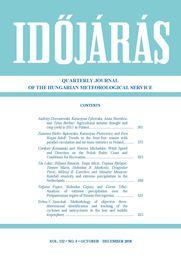IDŐJÁRÁS - angol nyelvű folyóirat
Vol. 122, No. 4 * Pages 361–462 * October - December 2018
 |
|
 letöltés [pdf: 2129 KB]
letöltés [pdf: 2129 KB]
Agricultural autumn drought and crop yield in 2011 in Poland
Andrzej Doroszewski, Katarzyna Żyłowska, Anna Nieróbca, and Tytus Berbeć
DOI:10.28974/idojaras.2018.4.1 (p. 361–)
Andrzej Doroszewski, Katarzyna Żyłowska, Anna Nieróbca, and Tytus Berbeć
DOI:10.28974/idojaras.2018.4.1 (p. 361–)
IDŐJÁRÁS folyóirat

Az IDŐJÁRÁS a HungaroMet Nonprofit Zrt. negyedévenként megjelenő angol nyelvű folyóirata
Megrendelhető a journal.idojaras@met.hu címen.
A szerzőknek szánt útmutató itt olvasható.
Megrendelhető a journal.idojaras@met.hu címen.
A szerzőknek szánt útmutató itt olvasható.









